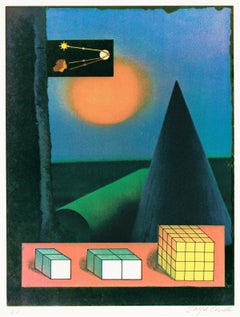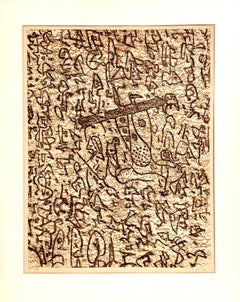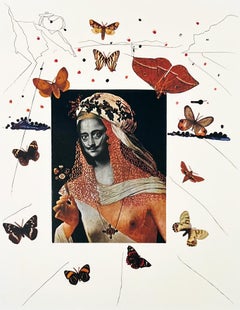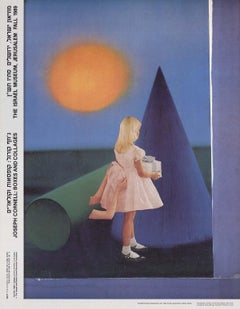Joseph Cornell Art
American, 1903-1972
Joseph Cornell (December 24, 1903 – December 29, 1972) was an American visual artist and film maker, one of the pioneers and most celebrated exponents of assemblage. Influenced by the Surrealists, he was also an avant-garde experimental filmmaker. He was largely self-taught in his artistic efforts, and improvised his own original style incorporating cast-off and discarded artifacts.to
1
Overall Width
to
Overall Height
to
1
1
1
1
1
1
1
1
9,958
2,750
1,376
1,371
1
Artist: Joseph Cornell
How to Make a Rainbow
By Joseph Cornell
Located in New York, NY
A very good impression of this color screenprint with varnish and stencil. Artist's proof, aside from the edition of 125. Signed and inscribed "A.P." in pencil. Printed by Styria Stu...
Category
1970s Surrealist Joseph Cornell Art
Materials
Varnish, Color, Screen, Stencil
Related Items
Max Ernst Dada Surrealist Hand Signed Lithograph Poster for a Jewish Museum
By Max Ernst
Located in Surfside, FL
Max Ernst (German, American, 1891-1976)
Color lithograph
Titled, "Poster For The Jewish Museum"
1966
Hand signed lower right
Hand numbered HC I/XVII
Dimensions: 34.75 x 28.5 sight 25 X 19.25
Max Ernst (German 1891 – 1976) was a German-born painter, sculptor, printmaker, graphic artist, and poet. A prolific artist, Ernst was a primary pioneer of the Dada movement and surrealism in Europe. He had no formal artistic training, but his experimental attitude toward the making of art resulted in his invention of frottage—a technique that uses pencil rubbings of textured objects and relief surfaces to create images—and grattage, an analogous technique in which paint is scraped across canvas to reveal the imprints of the objects placed beneath.
Max Ernst showed for the first time in 1912 at the Galerie Feldman in Cologne. At the Sonderbund exhibition of that year in Cologne he saw the work of Paul Cezanne, Edvard Munch, Pablo Picasso, Paul Gauguin and Vincent van Gogh. In 1913 he met Guillaume Apollinaire and Robert Delaunay and traveled to Paris. Ernst participated that same year in the Erste deutsche Herbstsalon.
In 1914 he met Jean Arp in Cologne who was to become a lifelong friend. In 1921 Ernst exhibited at the Galerie au Sans Pareil in Paris. He was involved in Surrealist activities in the early 1920s with Paul Eluard and André Breton. His work was exhibited that year together with that of the Das Junge Rheinland group, at Galerie Feldman in Cologne, and then in several group exhibitions in 1913. In his paintings of this period, Ernst adopted an ironic style that juxtaposed grotesque elements alongside Cubist and Expressionist motifs.
Ernst fought in world war I. Several German Expressionist painters died in action during the war, among them August Macke and Franz Marc. In 1918, Ernst was demobilised and returned to Cologne. He soon married art history student Luise Straus, of Jewish ancestry, whom he had met in 1914. In 1919, he visited Paul Klee in Munich and studied paintings by Giorgio de Chirico. In the same year, inspired by de Chirico and mail-order catalogues, teaching-aide manuals and similar sources, he produced his first collage works (notably Fiat modes, a portfolio of lithographs), a technique which later dominated his artistic pursuits. Also in 1919, Ernst, social activist Johannes Theodor Baargeld and several colleagues founded the Cologne Dada group. In 1919–20, Ernst and Baargeld published various short-lived magazines such as Der Strom, die Schammade and organised Dada exhibitions.
Ernst and Luise's son Ulrich Jimmy Ernst was born on 24 June 1920; he later would also become a painter. In 1921, he met Paul Éluard, who became a lifelong friend. Éluard bought two of Ernst's paintings (Celebes and Oedipus Rex) and selected six collages to illustrate his poetry collection Répétitions. A year later the two collaborated on Les malheurs des immortels and then with André Breton, whom Ernst met in 1921, on the magazine Littérature.
Ernst developed a fascination with birds which was prevalent in his work. His alter ego in paintings, which he called Loplop, was a bird. He suggested that this alter-ego was an extension of himself stemming from an early confusion of birds and humans. In 1927, he married Marie-Berthe Aurenche and it is thought his relationship with her may have inspired the erotic subject matter of The Kiss and other works of that year.
He collaborated with Joan Miro on designs for Sergei Diaghilev Ballet that same year. The following year the artist collaborated with Salvador Dali and the Surrealist Luis Bunuel on the film L'Age d'or. His first American show was held at the Julien Levy Gallery, New York, in 1932. In 1936 Ernst was represented in Fantastic Art, Dada, Surrealism at the Museum of Modern Art in New York. Ernst began to sculpt in 1934 and spent time with Alberto Giacometti. In 1938, the American heiress and artistic patron Peggy Guggenheim acquired a number of Max Ernst's works, which she displayed in her new gallery in London.
Ernst and Guggenheim were married from 1942 to 1946.
In September 1939, the outbreak of World War II caused Ernst, being German, to be interned as an "undesirable foreigner" in Camp des Milles, near Aix-en-Provence, along with fellow surrealist, Hans Bellmer, who had recently emigrated to Paris. He had been living with his lover and fellow surrealist painter, Leonora Carrington who, not knowing whether he would return, saw no option but to sell their house to repay their debts and leave for Spain. Thanks to the intercession of Paul Éluard and other friends, including the journalist Varian Fry, he was released a few weeks later. Soon after the German occupation of France, he was arrested again, this time by the Gestapo, but managed to escape to America with the help of Fry and Peggy Guggenheim, a member of a wealthy American art collecting family. Ernst and Peggy Guggenheim arrived in the United States in 1941 and were married at the end of the year. Along with other artists and friends (Marcel Duchamp and Marc Chagall) who had fled from the war and lived in New York City, Ernst helped inspire the development of abstract expressionism. His marriage to Guggenheim did not last. In October 1946 he married American surrealist painter Dorothea Tanning in a double ceremony with Man Ray and Juliet P. Browner in Beverly Hills, California. The couple made their home in Sedona, Arizona from 1946 to 1953. He and Tanning hosted intellectuals and European artists such as Henri Cartier-Bresson and Yves Tanguy. Sedona proved an inspiration for the artists and for Ernst, who compiled his book Beyond Painting and completed his sculptural masterpiece Capricorn while living in Sedona. As a result of the book and its publicity, Ernst began to achieve financial success. From the 1950s he lived mainly in France. In 1954 he was awarded the Grand Prize for painting at the Venice Biennale.
In 2005, "Max Ernst: A Retrospective" opened at the Metropolitan Museum of Art. Contemporary artist tapestries have had their true believers. He produced a tapestry for Gloria Ross...
Category
1960s Surrealist Joseph Cornell Art
Materials
Lithograph
Surrealist Portrait of Dali Surrounded by Butterflies, Memories of Surrealism
By Salvador Dalí
Located in Washington, DC
Artist: Salvador Dali
Title: Surrealist Portrait of Dali Surrounded by Butterflies
Portfolio: Memories of Surrealism
Medium: Etching and photolithograph
Date: 1971
Edition: AP XIV/XX...
Category
1970s Surrealist Joseph Cornell Art
Materials
Etching, Lithograph
$4,195
H 35.5 in W 29.5 in
Invasion de l'Espace - Lithograph by Man Ray - 1975
By Man Ray
Located in Roma, IT
Invasion de l'espace is a color lithograph by the American artist and exponent of Dadaism and Surrealism Man Ray (Philadelphia, 1890 - Paris, 1976).
The workr was edited by the Fr...
Category
1970s Surrealist Joseph Cornell Art
Materials
Lithograph
$497 Sale Price
30% Off
H 12.29 in W 9.14 in D 0.04 in
Invasion de l'Espace - Lithograph by Man Ray - 1975
By Man Ray
Located in Roma, IT
Invasion de l'espace is a color lithograph by the American artist and exponent of Dadaism and Surrealism Man Ray (Philadelphia, 1890 - Paris, 1976).
The workr was edited by the Fr...
Category
1970s Surrealist Joseph Cornell Art
Materials
Lithograph
Jean Dubuffet - Le Hochet - Original Screenprint
By Jean Dubuffet
Located in Collonge Bellerive, Geneve, CH
Jean Dubuffet
Banque de L'Hourloupe
Original Card with a title card
Original edition of 350 numbered sets with 30 hors commerce
Dimensions: 25 x 16 cm
Screen printed by Kelpra Studios, London Editions Alecto, London 1967
Jean Dubuffet (1901 - 1985)
Jean Dubuffet was born on July 31, 1901, in Le Havre, France. He attended art classes in his youth and in 1918 moved to Paris to study at the Académie Julian, which he left after six months. During this time, Dubuffet met Raoul Dufy, Max Jacob, Fernand Léger, and Suzanne Valadon and became fascinated with Hans Prinzhorn's book on psychopathic art. He traveled to Italy in 1923 and South America in 1924. Then Dubuffet gave up painting for about ten years, working as an industrial draftsman and later in the family wine business. He committed himself to becoming an artist in 1942.
Dubuffet's first solo exhibition was held at the Galerie René Drouin, Paris, in 1944; the Pierre Matisse Gallery gave him his first solo show in New York in 1947. During the 1940s, the artist associated with André Breton, Georges Limbour, Jean Paulhan, and Charles Ratton...
Category
1960s Abstract Impressionist Joseph Cornell Art
Materials
Screen
$1,420
H 9.85 in W 6.3 in D 0.04 in
(after) Alberto Magnelli - Composition - Pochoir
By Alberto Magnelli
Located in Collonge Bellerive, Geneve, CH
(after) Alberto Magnelli
Untitled (Cubist Composition) after the collage
Pochoir on paper
Conditions: excellent
32 x 24 cm
1956
Printed by Daniel Jacomet for XXe Siecle (issue number...
Category
1950s Abstract Geometric Joseph Cornell Art
Materials
Stencil
Takashi Murakami - Let us Devote Our Hearts, bright pink colors and flowers
By Takashi Murakami
Located in Dallas, TX
This collectible work on paper by Murakami is edition # 78 of 300. It comes unframed.
One of the most acclaimed artists to emerge from post-war Asia, Takashi Murakami is known for h...
Category
2010s Pop Art Joseph Cornell Art
Materials
Paper, Varnish, Offset
Ultra Surrealist Corpuscular Galutska, from 1971 Memories of Surrealism
By Salvador Dalí
Located in Washington, DC
Artist: Salvador Dali
Title: Ultra Surrealist Corpuscular Galutska
Portfolio: Memories of Surrealism
Medium: Etching and photolithograph
Date: 1971
Edition: AP XIV/XXV (artist's proo...
Category
1970s Surrealist Joseph Cornell Art
Materials
Etching, Lithograph
$4,195
H 35.5 in W 29.5 in
Black/White/Black
By Ellsworth Kelly
Located in Philadelphia, PA
Black/White/Black, 1970
Screenprint in colors on Special Arjomari
Edition of 75 42 1/4 x 29 3/4 in.
Publisher: Gemini G.E.L., Los Angeles
Category
Late 20th Century Joseph Cornell Art
Materials
Screen
(after) Robert Delaunay - La fenêtre no. 2 - Pochoir
Located in Collonge Bellerive, Geneve, CH
(after) Robert Delaunay - La fenêtre no. 2 - Pochoir
From the literary review "XXe Siècle"
1957
Dimensions: 32 x 24 cm
Publisher: G. di San Lazzaro.
Category
1950s Abstract Geometric Joseph Cornell Art
Materials
Stencil
$1,894
H 12.6 in W 9.45 in D 0.04 in
Invasion de l'espace - Original Lithograph by Man Ray - 1975
By Man Ray
Located in Roma, IT
Invasion de l'espace is an original print by the American artist and exponent of Dadaism Man Ray (Philadelphia 1890 - Paris 1976).
This color lithograph on paper, was edited by the ...
Category
1970s Surrealist Joseph Cornell Art
Materials
Lithograph
$461 Sale Price
35% Off
H 12.29 in W 9.14 in D 0.04 in
Serge Poliakoff (after) - Composition - Pochoir
By Serge Poliakoff
Located in Collonge Bellerive, Geneve, CH
Serge Poliakoff (after) - Composition - Pochoir
Published in the deluxe art review, XXe Siecle
1956
Dimensions: 32 x 24 cm
Publisher: G. di San Lazzaro.
Unsigned and unumbered as is...
Category
1950s Abstract Expressionist Joseph Cornell Art
Materials
Stencil
Previously Available Items
1989 Joseph Cornell 'The Gift' Contemporary Multicolor, Blue, Green, Yellow Israel
By Joseph Cornell
Located in Brooklyn, NY
Paper Size: 23.5 x 18.25 inches ( 59.69 x 46.355 cm )
Image Size: 22.75 x 16.5 inches ( 57.785 x 41.91 cm )
Framed: No
Condition: B: Very Good Condition, with signs of handling o...
Category
1980s Joseph Cornell Art
Materials
Offset
H 23.5 in W 18.25 in D 0.1 in
1989 Joseph Cornell 'The Gift' Contemporary Multicolor, Blue, Green, Yellow Israel
By Joseph Cornell
Located in Brooklyn, NY
Paper Size: 23.5 x 18.25 inches ( 59.69 x 46.355 cm )
Image Size: 22.75 x 16.5 inches ( 57.785 x 41.91 cm )
Framed: No
Condition: B: Very Good Condition, with signs of handling o...
Category
1980s Joseph Cornell Art
Materials
Offset
H 23.5 in W 18.25 in D 0.1 in
Joseph Cornell Original Scrapbook for Tamara Toumanova
By Joseph Cornell
Located in New York, NY
Illustrated with 10 original Cornell collages interleaved in coloured and textured papers, constructed of black and white photographs, feathers, fabric from Toumanova's costumes, tulle, plastic, coloured paper, rhinestones, string, etc. Housed in original red-coloured ringbinder with collaged covers by Cornell. Folio, 285 x 230 mm, (exterior measurement of notebook 11 x 9 inches). New York: ca. 1953.
Original Collage Scrapbook on Russian ballet star Tamara Toumanova, constructed by Joseph Cornell (1903-1972) in the early 1950s.
Ballet was central to both the life and the work of Joseph Cornell. Until the time of his first encounter with Toumanova in 1940, his main preoccupation was with the Romantic ballet. However, once he came under her spell she occupied the main focus of his balletomania for the next thirty years. "The two ballerinas who made the greatest imprint on Cornell's work were Fanny Cerrito [1817-1909] and Tamara Toumanova [1919-1996]. They were his first loves in the ballet, making their entry into his life within a few months of each other, Cerrito in the summer of 1940, Toumanova in the winter of the same year." (Starr, Joseph Cornell and the Ballet, p. 59).
Cornell was a frequent visitor to Toumanova's dressing room during the time she danced at the Metropolitan Opera House and for the George Balanchine Company. After Toumanova departed for Hollywood, she and Cornell entered into a lengthy correspondence and the artist presented Toumanova with several of his art works, one being the present album.
In all, Cornell constructed over twenty objects of various sorts all inspired by Toumanova and her ballet creations. There were scrapbooks, souvenir cases, classic Cornell boxes, make-up trays, decorated hand-mirrors, etc., each incorporating scenes and objects from her work in Swan Lake, The Nutcracker, and Romeo and Juliet. As Sandra Starr has pointed out, even though she was a living ballerina, as opposed to the dead ones he had previously focused on, Cornell's interest in Toumanova centered on her roles in nineteenth-century ballets and much less on the modern works in which she danced for Balanchine.
Original Cornell construction of ten collages on a personal subject close to the artist's heart. With a splendid provenance, beginning with the subject of the construction, Tamara Toumanova herself. Then to the great Cornell collectors, Lindy and Edwin Bergman. Minor signs of wear to extremities of binder, a few leaves with edge wear.
PROVENANCE: Tamara Toumanova, who acquired the notebook as a gift from the artist, thence to the Bergman Collection, acquired in 1981; Private Collection.
Exhibited:
1.) New York, The Museum of Modern Art and Chicago, The Art Institute of Chicago, Joseph Cornell, January-March 1982 (this work exhibited only at the Art Institute of Chicago).
2.) Washington, D.C., National Museum of American Art, Joseph Cornell: An Exploration of Sources, November 1982-February 1983.
3.) Art Institute of Chicago, The Lindy and Edwin Bergman Joseph Cornell Collection, June 1983-October 1989.
4.) Washington, D.C., Smithsonian American Museum of Art; Salem, MA, Peabody Essex Museum of Art, and the San Francisco Museum of Modern Art, Joseph Cornell: Navigating the Imagination, November 2006-January 2008, pp. 282-283, cat. no. 130 (illustrated in colour).
References: See, Sandra Leonard...
Category
1950s American Modern Joseph Cornell Art
Joseph Cornell art for sale on 1stDibs.
Find a wide variety of authentic Joseph Cornell art available for sale on 1stDibs. If you’re browsing the collection of art to introduce a pop of color in a neutral corner of your living room or bedroom, you can find work that includes elements of blue and other colors. You can also browse by medium to find art by Joseph Cornell in mixed media, screen print, stencil and more. Much of the original work by this artist or collective was created during the 20th century and is mostly associated with the Surrealist style. Not every interior allows for large Joseph Cornell art, so small editions measuring 9 inches across are available. Customers who are interested in this artist might also find the work of Victor Brauner, Mark Ryden, and Alan Turner. Joseph Cornell art prices can differ depending upon medium, time period and other attributes. On 1stDibs, the price for these items starts at $75 and tops out at $55,000, while the average work can sell for $6,400.




